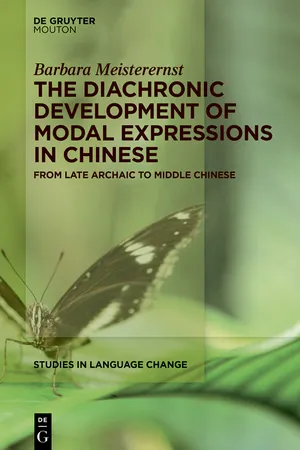
The Diachronic Development of Modal Expressions in Chinese
From Late Archaic to Middle Chinese
- 385 pages
- English
- ePUB (mobile friendly)
- Available on iOS & Android
The Diachronic Development of Modal Expressions in Chinese
From Late Archaic to Middle Chinese
About this book
The present study is the first to apply a syntactic approach to the grammaticalization of Chinese modals, based on hypotheses on cross-linguistic diachronic developments of modals from lexical to functional categories as upward movement on a functional spine. The temporal framework of the study covers Late Archaic and Middle Chinese. Early Middle Chinese is a crucial turning point for the development of Chinese from a more synthetic to a more analytic language. This change is attributed e.g. to the loss of a former morphology, which also affects the modal system. Against this background, the negative cycle of Chinese, the relevance of polarity contexts, and the development of a new system of deontic, epistemic and future markers are analyzed.
In addition to a comprehensive analysis of the syntactic processes involved in the diachronic changes of the Chinese modal system, the study also provides a comparison with the syntax of grammaticalization of the thoroughly discussed Germanic modals. This constitutes a broad basis for further analyses of the changes in the Chinese language during its long written history, but also for cross-linguistic studies on the syntax of grammaticalization and on linguistic universals.
Frequently asked questions
- Essential is ideal for learners and professionals who enjoy exploring a wide range of subjects. Access the Essential Library with 800,000+ trusted titles and best-sellers across business, personal growth, and the humanities. Includes unlimited reading time and Standard Read Aloud voice.
- Complete: Perfect for advanced learners and researchers needing full, unrestricted access. Unlock 1.4M+ books across hundreds of subjects, including academic and specialized titles. The Complete Plan also includes advanced features like Premium Read Aloud and Research Assistant.
Please note we cannot support devices running on iOS 13 and Android 7 or earlier. Learn more about using the app.
Information
Table of contents
- Title Page
- Copyright
- Contents
- Acknowledgments
- Abbreviations
- Introduction
- 1 The different modal categories in Late Archaic and Early Middle Chinese and their realization
- 2 The diachronic development of deontic modals in Early Middle Chinese
- 3 Modality and future marking in Late Archaic and Middle Chinese
- 4 Postverbal modals: The case of De
- 5 More on negation and polarity
- 6 A brief overview on the cross-linguistic development of modals
- Conclusion
- Index